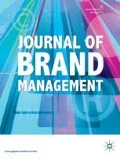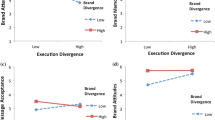Abstract
Can the sequence in which ad exposures are generated across various ad formats enhance or inhibit communication outcomes in low-involvement situations? This study compares the effect of self-selected and forced-exposure (or intrusive) ad exposure sequences with repeated exposures of single ad formats on brand recall, brand attitude and stimulus-based inclusion in the consideration set. Analysis of experimental data shows that the sequence of self-selected ad formats that induce pre-attentive processing of ad information followed by forced-exposure ad formats that induce conscious processing, leads to superior outcomes compared with others. Prior research on priming supports the findings and implications for media planning, are addressed.
Similar content being viewed by others
References
Bornstein, R.F. and D'Agostino, P.R. (1994) The attribution and discounting of perceptual fluency: Preliminary tests of a perceptual fluency/attributional model of the mere exposure effect. Social Cognition 12: 103–128.
Cacioppo, J. and Petty, R. (1979) Effects of message repetition and position on cognitive response, recall, and persuasion. Journal of Personality and Social Psychology 37: 97–109.
Chatterjee, P., Hoffman, D.L. and Novak, T.P. (2003) Modeling the clickstream: Implications for web-based advertising efforts. Marketing Science 22 (4): 520–541.
Chattopadhyay, A. and Nedungadi, P. (1992) Does attitude toward the ad endure? The moderating effects of attention and delay. Journal of Consumer Research 19 (1): 26–33.
Dahlen, M. (2001) Banner advertisements through a new lens. Journal of Advertising Research 41 : 23–30.
Danaher, P. and Mullarkey, G. (2003) Factors affecting online advertising recall: A study of students. Journal of Advertising Research 43 (3): 252–267.
Dijkstra, M., Buijtels, H.E.J.J.M. and van Raaij, W.F. (2005) Sperate and joint effects of medium type on consumer responses: A comparison of television, print, and the internet. Journal of Business Research 58: 377–386.
Dreze, X. and Hussherr, F. (2003) Internet advertising: Is anybody watching. Journal of Interactive Marketing 17 (4): 8–23.
Edell, J.A. and Keller, K.L. (1989) The information processing of coordinated media campaigns. Journal of Marketing Research 26: 149–163.
Janiszewski, C. (1998) The influence of display characteristics on visual exploratory search behaviour. Journal of Consumer Research 25: 290–301.
Krishnan, H.S. and Chakravarti, D. (1999) Memory measures for pretesting advertisements: An integrative conceptual framework and a diagnostic template. Journal of Consumer Psychology 8: 1–37.
Lee, A. and Labroo, A. (2004) The effect of conceptual and perceptual fluency on brand evaluation. Journal of Marketing Research XLI (May): 151–165.
MacInnis, D., Moorman, C. and Jaworski, B.J. (1991) Enhancing and measuring consumer motivation, opportunity and ability to process brand information from ads. Journal of Marketing 55 (October): 32–53.
Nordheilm, C. (2002) The influence of level of processing on advertising repetition effects. Journal of Consumer Research 29 (December): 371–382.
Pechmann, C. and Stewart, D. (1988) Advertising repetition: A critical review of wearin and wearout. Current Issues and Research in Advertising 11: 285–329.
Petty, R.E. and Cacioppo, J.T. (1986) The Elaboration Likelihood Model of Persuasion. New York: Academic Press.
Rodgers, S. (2004) The effects of sponsor relevance on consumer reactions to internet sponsorships. Journal of Advertising 32 (4): 67–76.
Shapiro, S., MacInnis, D.J. and Heckler, S.E. (1997) The effects of incidental ad exposure on the formation of consideration sets. Journal of Consumer Research 24: 94–104.
Shavitt, S., Vargas, P. and Lowrey, P. (2004) Exploring the role of memory for self-selected ad experiences: Are some advertising media better liked than others? Psychology and Marketing 21 (12): 1011–1032.
Smith, R.E. and Swinyard, W.R. (1982) Information response models: An Integrated approach. Journal of Marketing 46 (1): 81–93.
Tassavoli, N.T. (1998) Language in multimedia: Interaction of spoken and written information. Journal of Consumer Research 25 (1): 26–37.
Vakratsas, D. and Ambler, T. (1999) How advertising works: What do we really know? Journal of Marketing 63 (January): 26–43.
Zajonc, R.B. (1968) Attitudinal effects of mere exposure. Journal of Personality and Social Psychology 9 (2, part 2): 1–28.
Author information
Authors and Affiliations
Corresponding author
Rights and permissions
About this article
Cite this article
Chatterjee, P. Can unconscious–conscious processing sequences enhance ad exposure outcomes?. J Brand Manag 18, 506–515 (2011). https://doi.org/10.1057/bm.2011.9
Received:
Revised:
Published:
Issue Date:
DOI: https://doi.org/10.1057/bm.2011.9




